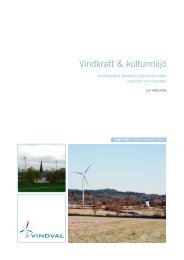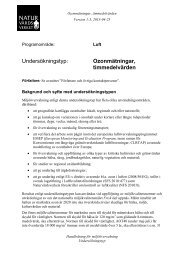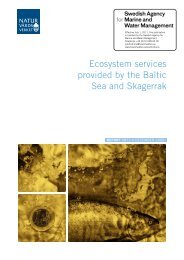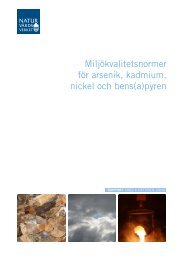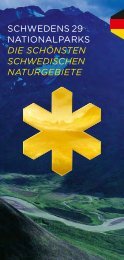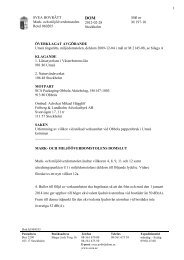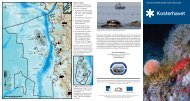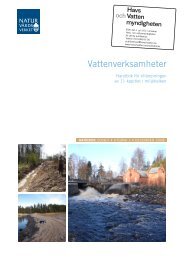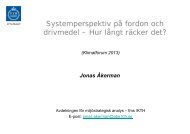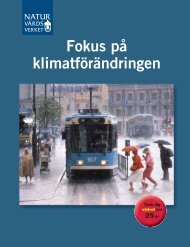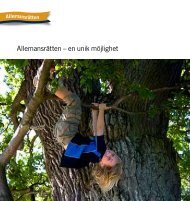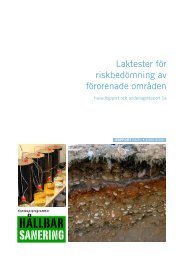The process of creating Biosphere Reserves- An ... - Naturvårdsverket
The process of creating Biosphere Reserves- An ... - Naturvårdsverket
The process of creating Biosphere Reserves- An ... - Naturvårdsverket
You also want an ePaper? Increase the reach of your titles
YUMPU automatically turns print PDFs into web optimized ePapers that Google loves.
SWEDISH ENVIRONMENTAL PROTECTION AGENCY REPORT 6563<br />
<strong>The</strong> <strong>process</strong> <strong>of</strong> <strong>creating</strong> <strong>Biosphere</strong> <strong>Reserves</strong><br />
5 Summary reflections and<br />
recommendations<br />
Policy documents, as well as research within democracy and nature resource management,<br />
argue that the participation <strong>of</strong> the general public in nature resource management,<br />
leads to a wider knowledge base/knowledge exchange and more sustainable<br />
decisions on the environment. <strong>The</strong> way in which different stakeholders communicate<br />
the <strong>Biosphere</strong> concept and partake in the <strong>Biosphere</strong> work, has consequences<br />
for how the <strong>Biosphere</strong> <strong>Reserves</strong> develop in the long term.<br />
A central task during the candidature phase, but also after the areas had been <strong>of</strong>ficially<br />
approved as <strong>Biosphere</strong> <strong>Reserves</strong>, was to supply the <strong>Biosphere</strong> concept with<br />
attractive content. Through communicative <strong>process</strong>es, different stakeholders attributed<br />
different meanings to what the concept <strong>of</strong> a <strong>Biosphere</strong> Reserve comprises.<br />
<strong>The</strong>se meanings can in the long term be normative over what one can or cannot do<br />
in a <strong>Biosphere</strong> Reserve, which in time can develop into new informal regulations<br />
and attitudes to the location (cf. Sandström, 2008). Our view is that the identity and<br />
norm development in the various <strong>Biosphere</strong> <strong>Reserves</strong> is still in its infancy. Kristianstad<br />
Wetland has come furthest, and here one can say that the <strong>Biosphere</strong> work<br />
has contributed to the altering <strong>of</strong> people’s perceptions <strong>of</strong> a “water-soaked landscape<br />
in need <strong>of</strong> draining” to a perception <strong>of</strong> a “wetland” landscape with unique<br />
features worth preserving. This new way <strong>of</strong> relating to ones physical environment<br />
has similarities to the French modernist Dushamp’s art vision or paradigm shift, i.e.<br />
when the viewer <strong>of</strong> an object or a landscape makes a complete about face in their<br />
views (cf. Brulin and Emriksson, 2005). Common to all <strong>Biosphere</strong> initiatives is that<br />
they contribute to people beginning to see their surroundings through new eyes,<br />
which in the long term gives the opportunity to generate new life force and location<br />
identity.<br />
Our review shows that the implementation <strong>process</strong>es to achieve <strong>Biosphere</strong> Reserve<br />
status are marked by different forms <strong>of</strong> governance and participation. Interactive<br />
governance (Hedlund & Montin, 2009:32) conceptualises the social phenomenon<br />
that in recent decades made its mark on policy after policy in Sweden, not least<br />
within the Swedish Nature Conservation Policy. Interactive governance is characterised<br />
by a transition from a more hierarchical form <strong>of</strong> government, to a more<br />
collaboratively directed and network-based form <strong>of</strong> government, which is distinguished<br />
among other things by a wish to involve a diversity <strong>of</strong> stakeholders. Interactive<br />
governance is <strong>of</strong>ten seen as a way to anchor decisions made, and facilitate<br />
implementation. (Hedlund and Montin, 2009)<br />
<strong>The</strong> interactive governance in the five <strong>Biosphere</strong> <strong>Reserves</strong> investigated differ however,<br />
which to a certain extent has to do with the origins <strong>of</strong> the initiative, but also<br />
land ownership, earlier organisational arrangements, financing and natural geographical<br />
prerequisites etc. In Kristianstad Wetland the work has to a large extent<br />
been a municipal matter, dependent upon a couple <strong>of</strong> driven enthusiasts, where<br />
59



